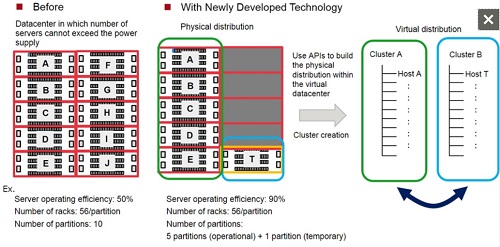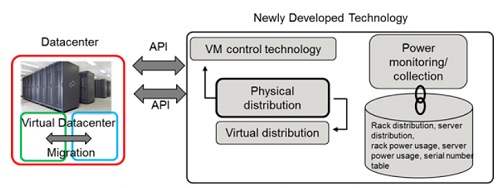|
Fujitsu Develops Virtual Machine Control Technology to Improve Server Density of Datacenter Racks
KAWASAKI, Japan, Jun 27, 2017 - (JCN Newswire) - Fujitsu Laboratories Ltd. announces the development of virtual machine (VM) control technology that improves server rack mounting density for each datacenter rack.
 | | Figure 1: Increasing server mounting density in a datacenter |
 | | Figure 2: VM control technology based on physical distribution |
 | | Figure 3: Technology for setting rules for server installation |
Currently, in datacenters, the number of servers mounted to a rack is limited by the total rated electrical power of the servers, which must be less than the power supply of the rack. However, often times, server load is low, at approximately 10% to 50%, and power usage for each rack proportional to load is also low compared to the rated power, leading to racks with low server mounting density. Now, in order to increase server mounting density, Fujitsu Laboratories has developed technology that enables efficient server placement by setting up a partition made up of backup servers in the datacenter, and migrating VMs to the backup partition based on the physical distribution and power consumption of the virtual machines.
With this technology, for racks that are running virtual servers, datacenters can reduce their space usage by increasing mounting density. Fujitsu Laboratories has calculated that in a case where server rack operational efficiency(1) was increased to 90%, space usage could be reduced by 40%.
Details of this technology were presented at IEEE Cloud 2017, an international conference currently being held in Honolulu, U.S., from June 25-30.
Development Background
As the number of servers installed in datacenters continues to rise and its further increase is expected with the growth of AI and IoT systems going forward, there has been a demand for ways to increase server mounting density within the bounds of limited space and power.
Issues
In datacenters, when installing servers in a rack, the number of servers is decided based on the rated power usage of each server, so as not to exceed the rack's power supply. However, often times, server load is low, at approximately 10% to 50%, and power usage for each rack proportional to load is also low compared to the rated power. Being this low creates a demand to raise mounting density.
In response to this demand, in recent years a "power capping technology" has been developed which monitors the actual operational status of servers in racks that mount a number of servers in excess of their power supplies. If that power supply is about to be exceeded, the technology limits the operational frequency of servers to suppress power consumption. This technology, however, could not be used for applications that require a specified level of processing performance, such as mission-critical applications.
About the Newly Developed Technology
Now Fujitsu Laboratories has developed a VM control algorithm that first installs physical servers in racks at high density in a datacenter and then establishes a back-up partition, using the migration functionality of the VMs to move them depending on the power consumption of each server. In this way it prevents each rack from exceeding its amount of power supply.
Features of the newly developed technology are as follows:
1. VM control technology based on physical distribution
Virtual datacenters built with VM management software have physical servers split into theoretical management units called clusters. The physical servers within a cluster can be mounted into different racks, with no physical limitations. VMs are automatically migrated between clusters when a physical server stops operation due to a fault or when it undergoes maintenance. The actual physical layout of the servers, however, is not always taken into account.
Fujitsu Laboratories has now developed a technology that prevents racks from exceeding their power supplies. Using an API that can be used in normal datacenter management, the company will build a database related to the physical distribution (the operational partition) of servers that provides services as well as the physical distribution of the backup partition that the VMs will be migrated to as it approaches its power supply limits. Then, the continually changing power usage volume collected from the servers will be linked to their serial number and rack number (Figures 1 and 2). This technology enables datacenter operators to increase the mounting density in the operational partitions, reducing space usage.
http://www.acnnewswire.com/topimg/Low_FujitsuServer62717Fig1.jpg
Figure 1: Increasing server mounting density in a datacenter
http://www.acnnewswire.com/topimg/Low_FujitsuServer62717Fig2.jpg
Figure 2: VM control technology based on physical distribution
2. Technology to set installation rules based on actual operational data
Frequent migrations will occur if server mounting density is increased exceedingly, so an appropriate balance is necessary between migration frequency and server load commensurate with power volume. Fujitsu Laboratories has now developed a technology to determine the number of servers that should be mounted on a rack by statistically estimating the frequency of migrations for each rack, based on the pre-measured load per server, assuming that changes in the load follow the normal distribution (Figure 3). If the center of the normal distribution is a server load of 30%, for example, by installing servers based on a power usage value for 50% load, this would account for 95.5% of changes in load, enabling a maximization of server mounting density.
http://www.acnnewswire.com/topimg/Low_FujitsuServer62717Fig3.jpg
Figure 3: Technology for setting rules for server installation
Effects
By applying this technology, Fujitsu Laboratories expects that it will be possible to increase the mounting density of servers in datacenters, significantly reducing installation space. By using this newly developed technology, for example in a cloud service where changes in load can be predicted with a normal distribution, a datacenter operating with ten partitions at a server rack operating efficiency of 50% would be able to reduce space usage by 40%, with now five partitions and a server operating efficiency of 90%.
Future Plans
Fujitsu Laboratories plans to incorporate this technology into Fujitsu Software ServerView Infrastructure Manager, Fujitsu Limited's infrastructure software for operations and management, within fiscal 2018.
(1) Server rack operating efficiency
The ratio of the total power consumption of the servers to the power supply of the rack.
About Fujitsu Laboratories
Founded in 1968 as a wholly owned subsidiary of Fujitsu Limited, Fujitsu Laboratories Ltd. is one of the premier research centers in the world. With a global network of laboratories in Japan, China, the United States and Europe, the organization conducts a wide range of basic and applied research in the areas of Next-generation Services, Computer Servers, Networks, Electronic Devices and Advanced Materials. For more information, please see: http://www.fujitsu.com/jp/group/labs/en/.
Contact:Fujitsu Laboratories
Computer Systems Laboratory
E-mail: data-center-pr@ml.labs.fujitsu.com
Fujitsu Limited
Public and Investor Relations
Tel: +81-3-6252-2176
URL: www.fujitsu.com/global/news/contacts/
Source: Fujitsu Ltd
Sectors: Electronics, Cloud & Enterprise
Copyright ©2024 JCN Newswire. All rights reserved. A division of Japan Corporate News Network. |
Latest Release

First-ever Mazda CX-80 Crossover SUV Unveiled in Europe
Apr 19, 2024 13:50 JST
| 
Fujitsu develops technology to convert corporate digital identity credentials, enabling participation of non-European companies in European data spaces
Apr 19, 2024 10:17 JST
| 
Mitsubishi Heavy Industries and NGK to Jointly Develop Hydrogen Purification System from Ammonia Cracking Gas
Apr 18, 2024 17:01 JST
| 
Toyota Launches All-New Land Cruiser "250" Series in Japan
Apr 18, 2024 13:39 JST
| 
Fujitsu and Oracle collaborate to deliver sovereign cloud and AI capabilities in Japan
Apr 18, 2024 11:14 JST
| 
Eisai: Research on Treatments for Alzheimer's Disease Based on Its Pathological Mechanisms Recieves Award for Science and Technology (Research Category)
Apr 18, 2024 10:53 JST
| 
All-New Triton Confirmed as First Double-Cab Pickup Truck to Achieve 2024 Five-Star ANCAP Safety Rating
Apr 18, 2024 09:22 JST
| 
Eisai's Antiepileptic Drug Fycompa Injection Formulation Launched In Japan
Apr 17, 2024 16:17 JST
| 
Honda Unveils Next-generation EV Series for China
Apr 17, 2024 12:15 JST
| 
Lexus presents Time at the 2024 Milan Design Week
Apr 16, 2024 18:49 JST
| 
Mitsubishi Corporation Announces Participation in a DAC Project in Louisiana, USA
Apr 16, 2024 14:36 JST
| 
New circuit challenge for TOYOTA GAZOO Racing
Apr 15, 2024 17:21 JST
| 
TOYOTA GAZOO Racing back on asphalt for Croatian challenge
Apr 12, 2024 19:36 JST
| 
Heidelberg Materials North America Announces Latest Milestone in Edmonton CCUS Project
Apr 12, 2024 14:39 JST
| 
MHIAEL Completes Expansion of the its Nagasaki Plant for Manufacture of Aero Engine Combustors
Apr 11, 2024 18:08 JST
| 
Mitsubishi Shipbuilding Acquires Approval in Principle (AiP) from Classification Society ClassNK for Ammonia Fuel Supply System (AFSS)
Apr 11, 2024 17:50 JST
| 
DOCOMO, NTT, NEC and Fujitsu Develop Top-level Sub-terahertz 6G Device Capable of Ultra-high-speed 100 Gbps Transmission
Apr 11, 2024 15:10 JST
| 
Mitsubishi Corporation Announces Completion of Capital Raise by Nexamp
Apr 11, 2024 13:07 JST
| 
Mitsubishi Shipbuilding Receives Order for Ammonia Fuel Supply System for Ammonia-Powered Marine Engine
Apr 10, 2024 16:55 JST
| 
Transgene and NEC Present First Clinical Benefits of Neoantigen Cancer Vaccine, TG4050, in Head & Neck Cancer at AACR 2024
Apr 10, 2024 13:36 JST
|
More Latest Release >>
|